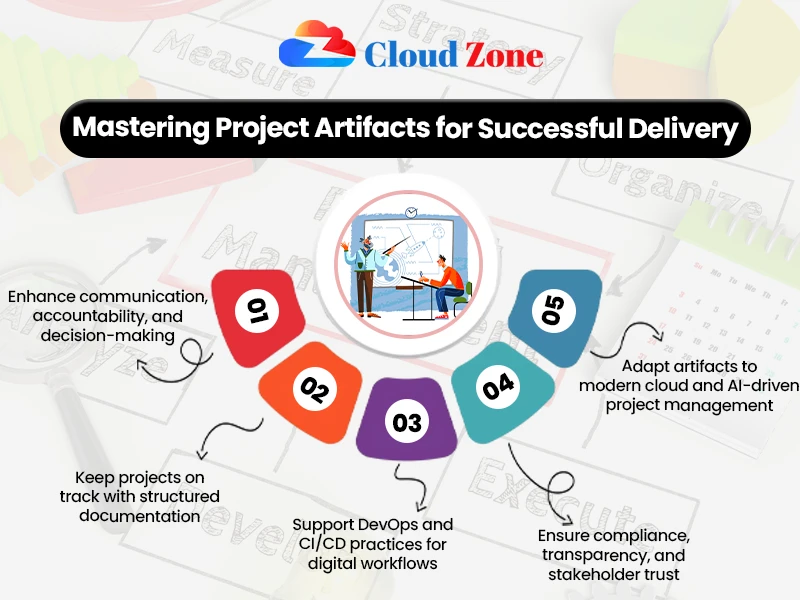Table of Contents
ToggleIntroduction
The question that is raised in the field of project delivery is what are artifacts in project management? In other words, artifacts are the actual products of the project working process, documents, schemes, plans, reports, and deliverables, indicating the progress and results of the project work. They are the road map of the way work is conducted and bring transparency among the stakeholders.
Learning about project management artifacts is crucial in enhancing communication, accountability, and decision-making. They ensure that they capture the path and the goal of a project, hence they cannot be done away with in successful execution.
For teams adopting DevOps practices, learning Azure DevOps CI/CD pipelines is critical for understanding how digital artifacts move through the pipeline.
Key Artifacts in Project Management
These include some of the most widespread project artifacts, such as:
Project Charter: Purpose, scope, and objectives.
Work Breakdown Structure (WBS): Describing tasks and responsibilities.
Project Schedule: This gives the timelines, milestones, and dependencies.
Risk Register: Records the possible risks and risk mitigation strategies.
Status reports: Report progress to stakeholders.
Deliverables: Physical products attainable to project objectives.
When you asked what are project artifacts in project management, remember they assist in keeping project teams on the right track, as well as ensuring work is done systematically.
To better understand the role of a DevOps engineer in managing artifacts, you can explore their responsibilities in coordinating workflows and deployments.

Types of Artifacts in Project Management
Artifacts may be largely categorized depending on their role or position in the project life cycle. Knowledge of such types will make teams aware of what artifacts they are supposed to create and how to utilize them efficiently:
Initiation Artifacts: Project charter, business case, stakeholder register.
Arts and Crafts Artifacts: Work Breakdown Structure (WBS), project schedule, budget plan, risk register.
Execution Artifacts: Status reports, design documents, software builds, prototypes.
Monitoring and Controlling Artifacts: Performance reports, change requests, issue logs, quality metrics.
Closure Artifacts: Final deliverables, lessons learned, project closure report.
Through the classification of project management artifacts, organizations would have simplified documentation, priority allocation of resources, and compliance in the project lifecycle.
What is an Artifact in Project Management?
The word may be abstract, and therefore what is an artifact in project management? It is simply anything that is recorded and that is evidence of project activity. Artifacts are organized and communicable, unlike verbal updates or ad-hoc notes.
- They serve as repositories of knowledge of present and upcoming projects.
- They trace the decisions, changes, and workflows.
- They guarantee compliance and regulation in controlled industries.
- They build trust in the stakeholders by being visible.
Therefore, answering what is an artifact in project management, teams will find its value in the evidence of organized conducting and cooperation.
For organizational adoption of DevOps principles, embracing a strong DevOps culture ensures artifacts are standardized, tracked, and automated.
Explore templates, reports, and tools used by top PM professionals.
What are Artifacts in Project Management and why it matter?
Although we are aware of what are project artifacts in project management, the other important thing is managing them with this. This makes artifacts available, traceable, and secure over the project lifecycle.
When you question what is artifact management, remember the following benefits:
Centralization: One object of truth of the artifacts.
Security: Restricted access to project-sensitive outputs.
Collaboration: Smoothing between distributed teams.
Versioning: Monitoring of the changes through several iterations.
Efficiency: The less duplication and the simplified retrieval.
Teams can explore what are DevOps tools to enhance artifact handling across development and deployment pipelines.
Real-World Examples of Project Artifacts
Construction: The building is constructed according to blueprints and safety reports to allow its adherence to laws. Inspection checklists serve as artifacts to monitor the quality at each level.
Software Development: Both the planning and technical work are documented in software development by source code and sprint backlog. Release notes are artifacts used to communicate updates to the stakeholders.
Healthcare: Workflow and compliance documents represent a way of patient care and control. The knowledge-sharing artifact of medical staff is training manuals.
Marketing: Content calendars and campaign plans define the plan of action and strategy. Analytics dashboards are artifacts that can be used to measure campaign effectiveness.
Discover proven methods to create artifacts that drive project success.
Artifact Management in DevOps and Cloud Environments
What is Artifact management is even more important as organizations continue to use DevOps. In this case, artifacts are not only documents but also compiled code, binaries, or images that can be transferred between environments. Examples of DevOps artifacts are:
Examples of DevOps artifacts include:
- Docker images
- Helm charts
- Software libraries
- Configuration files
- Build outputs
Effective artifact management can be learned through DevOps courses online and hands-on CI/CD pipeline experience. Additionally, understanding the role of Linux in cloud computing helps in managing artifact storage and execution in servers.
Best Practices for Project Artifacts in Project Management
To have the most valuable artifacts, teams may adhere to the following rules:
Defining Artifact Types Early: Determine the artifacts that are required.
Keep Common Templates: Have the same project to project consistency.
Automate Where Necessary: Artifact automation using DevOps pipelines.
Secure Storage: Artifacts should be stored in stable repositories.
Check and Revise: Revise the artifacts in accordance with changes in project requirements.
Enhance Accessibility: Ensuring that they are easily accessible to the stakeholders.
For teams bridging Agile and DevOps, understanding DevOps vs Agile helps define which artifacts are essential and how they evolve across sprints and pipelines. Additionally, practical knowledge about what a DevOps engineer does can clarify ownership and accountability of artifacts.
The Future of Artifact Management
The further digitalization and distributed nature of projects will lead to this becoming more automated and based on AI-driven insights as well as cloud-native repositories. Artifacts will no longer be the fixed recordings but the moving assets of knowledge that will be used in making predictions, in real-time decision-making, and meeting the new regulations. As the concepts of DevOps, containerization, or the use of AI-based project management tools become practically feasible, artifacts will become the source of work and the driving force of constant progress, and their role in this process will be more important than ever.
Challenges in Artifact Management
Even though teams follow best practices, they still encounter multiple challenges during artifact management:
Version Conflicts: It is possible to have inconsistencies when several team members are working on the same document or build.
Lack of Documentation: Artifacts that are not complete or are old make them less valuable in decision-making.
Poor Accessibility: The stakeholders might not have access to vital information without the centralized repository.
Security Risks: Teams actively secure sensitive artifacts; moreover, they consistently protect them against unauthorized access to ensure data integrity.
Overproduction: Moreover, developers generate unnecessary artifacts, and consequently, they create an overhead that adds no value.
These issues would only be resolved when you understand what are artifacts in project management, the difference in agile between DevOps pipeline automation, and explicit ownership of every artifact.

Conclusion
Then, what are artifacts in project management? They are the documented products, i.e., plans, reports, deliverables, and documents, which reflect the spirit of project advancement. These project management artifacts act as the foundation of planned implementation, starting with defining goals with a charter, proceeding to performance monitoring with reports.
The need for proper understanding of what is artifact management is more critical than ever, ensuring artifacts remain secure, accessible, and scalable. Modern DevOps practices, CI/CD
pipelines, and cloud workflows all reinforce the value of what are project artifacts in project management. Teams can also reference a broad cloud computing overview to see how this fits into the larger IT ecosystem.
By mastering how teams create and store artifacts, they immediately gain control and ultimately build long-term value from every project.

Sukhamrit Kaur
Sukhamrit Kaur is an SEO writer who loves simplifying complex topics. She has helped companies like Data World, DataCamp, and Rask AI create engaging and informative content for their audiences. You can connect with her on LinkedIn.



